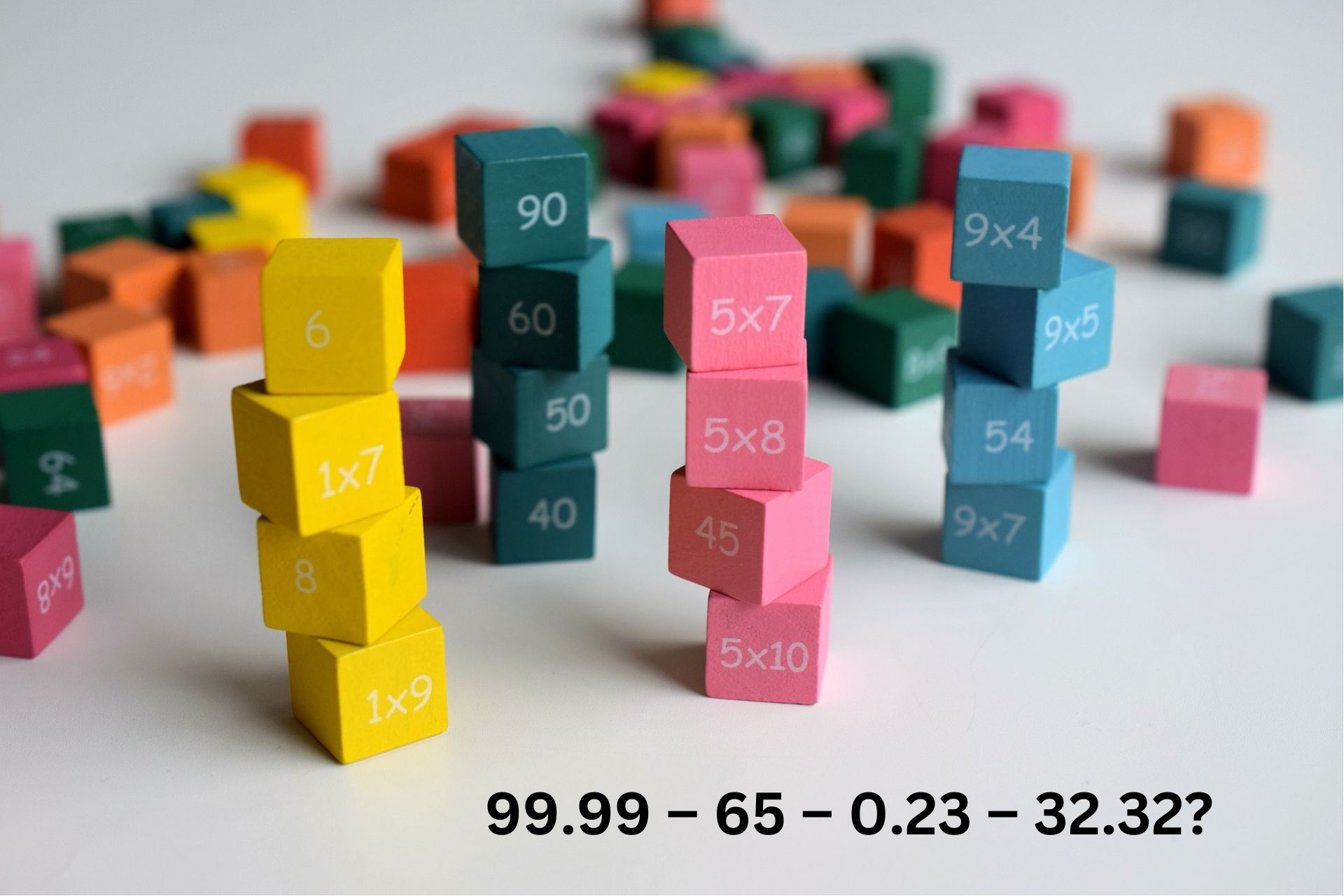Ever stumbled upon a sequence like 99.99 – 65 – 0.23 – 32.32 and wondered if it held any hidden meaning? At first glance, it may seem like a random set of numbers, but there’s more to this math puzzle than meets the eye. Today, we’re breaking down each step in this sequence and exploring why solving problems like these can be both fun and educational. Whether you’re a math enthusiast or someone who just enjoys a good puzzle, join us on this journey to uncover the final answer!
Contents
- 1 What Is 99.99 – 65 – 0.23 – 32.32 Really About?
- 2 Step-by-Step Breakdown of 99.99 – 65 – 0.23 – 32.32
- 3 Final Answer: The Solution to 99.99 – 65 – 0.23 – 32.32 Is 2.44
- 4 Why Does This Sequence Matter?
- 5 Tips for Solving Similar Problems
- 6 Common Mistakes to Avoid
- 7 Conclusion: Mastering 99.99 – 65 – 0.23 – 32.32 Step-by-Step
- 8 Frequently Asked Questions (FAQs)
What Is 99.99 – 65 – 0.23 – 32.32 Really About?
This sequence may appear to be a complex string of numbers, but 99.99 – 65 – 0.23 – 32.32 is actually a straightforward math problem involving a series of subtractions. Each step leads us closer to a final result, giving us a chance to practice working with decimals and multi-step calculations. By following each step precisely, we’ll get an accurate and satisfying solution.
Step-by-Step Breakdown of 99.99 – 65 – 0.23 – 32.32
Step 1: Starting with 99.99
Our initial value is 99.99—a number just shy of 100, setting up an interesting expectation for the end result. This initial value provides a clue that our final answer will still be relatively small. Starting with 99.99 allows us to work with a manageable, round number, making calculations more intuitive.
Key Tip: When you see a sequence like this, take note of the initial number. It helps you estimate the final answer and plan your approach!
Step 2: Subtracting 65 from 99.99
The first operation in our sequence is 99.99 – 65. Let’s tackle this carefully:
- 99.99 – 65 = 34.99
After subtracting 65, we’re left with 34.99. This step has effectively reduced our original number by a significant amount. As we proceed, it’s clear that each subtraction will leave us with a smaller, more refined result.
Quick Insight: Subtracting whole numbers first simplifies the sequence, allowing us to handle smaller values for the remaining decimal-based calculations.
Step 3: Subtracting 0.23 from 34.99
Now, we’ll subtract a smaller decimal from our current total of 34.99:
- 34.99 – 0.23 = 34.76
After subtracting 0.23, our total now stands at 34.76. Working with decimals like this might feel tricky, but taking it step-by-step keeps us accurate.
Helpful Hint: When dealing with decimal points, focus on one decimal place at a time. This makes the math feel less overwhelming and improves accuracy.
Step 4: The Final Subtraction—32.32
Finally, we come to the last number in our sequence: 32.32. Subtracting this from 34.76 will give us our ultimate answer:
- 34.76 – 32.32 = 2.44
And there you have it! After going through each subtraction, we’re left with a final answer of 2.44. This multi-step process was straightforward yet required precision, especially with decimal points.
Final Answer: The Solution to 99.99 – 65 – 0.23 – 32.32 Is 2.44
So, after carefully following each step in 99.99 – 65 – 0.23 – 32.32, we arrive at 2.44. By breaking down each subtraction individually, we ensured accuracy in our final result.
Why Does This Sequence Matter?
This sequence, while seemingly random, serves as a perfect example of real-life math skills. Sequences like 99.99 – 65 – 0.23 – 32.32 test our ability to work with decimals, improve focus, and offer a solid practice for mental math. Here’s why practicing with numbers like these can be beneficial:
- Boosts Calculation Accuracy: Handling decimals and sequential operations improves calculation precision, a useful skill in daily scenarios.
- Enhances Focus and Patience: Solving multi-step problems requires attention to detail and patience—essential for avoiding errors.
- Builds Confidence in Problem Solving: With practice, sequences like this become manageable, increasing math confidence overall.
Tips for Solving Similar Problems
If you found 99.99 – 65 – 0.23 – 32.32 intriguing, here are some valuable tips for tackling similar math problems:
Break Down Each Step
Rather than trying to solve it all at once, tackle each subtraction individually. This keeps the math manageable and helps avoid overwhelm.
Use a Calculator for Decimal Accuracy
Decimals can be tricky, especially in multi-step problems. Using a calculator is a great way to ensure accuracy, especially when precision is key.
Practice Regularly with Decimals
Working with decimals frequently—whether adding, subtracting, or multiplying—builds confidence and prepares you for real-life situations where decimals are common, such as budgeting or cooking measurements.
Common Mistakes to Avoid
Even though this subtraction sequence seems simple, it’s easy to make mistakes. Here are some common pitfalls and how to avoid them:
- Ignoring Decimal Points: Decimal points are crucial in each step. Make sure they align correctly to avoid incorrect answers.
- Rushing Through Steps: Take your time with each part to ensure that calculations are done properly.
- Mixing Up Operations: In multi-step sequences, double-check that you’re consistently subtracting and not accidentally adding.
Conclusion: Mastering 99.99 – 65 – 0.23 – 32.32 Step-by-Step
The sequence 99.99 – 65 – 0.23 – 32.32 may seem daunting at first, but breaking it down shows that even complex-looking problems can be simple with the right approach. Whether you’re refining your math skills or simply enjoying the satisfaction of solving a puzzle, practicing sequences like these is rewarding. By following each step carefully, you’ll find that even a seemingly random series of numbers can make sense!
Frequently Asked Questions (FAQs)
1. What’s the final answer to 99.99 – 65 – 0.23 – 32.32?
The final answer is 2.44 after subtracting each number in sequence.
2. Why is it important to work with decimal numbers like these?
Practicing with decimals boosts accuracy and prepares you for real-world scenarios that involve calculations, like budgeting.
3. Can I use a calculator for problems like this?
Absolutely! Calculators are helpful for verifying accuracy, especially with decimal points.
4. How can I avoid mistakes when solving similar problems?
Take each subtraction step-by-step, pay attention to decimal points, and double-check calculations for accuracy.
5. Is there a faster way to solve problems like 99.99 – 65 – 0.23 – 32.32?
Using a calculator and breaking the problem down step-by-step can improve speed and accuracy.











